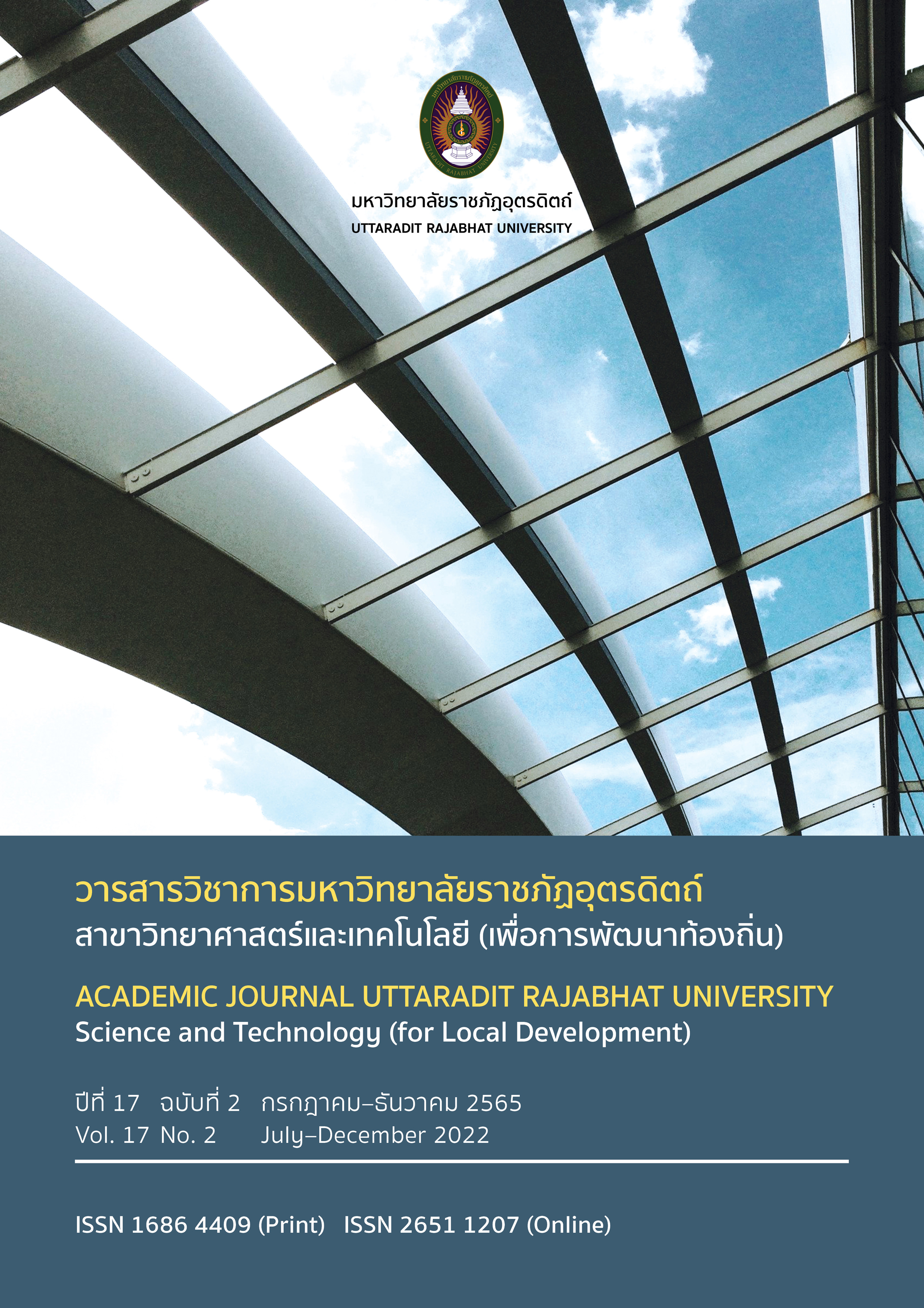การพัฒนาเทคโนโลยีการอบแห้งแบบป้องกันรังสีพลังงานแสงอาทิตย์ต้นทุนต่ำ สำหรับกลุ่มวิสาหกิจชุมชนกลุ่มดวงทอง จังหวัดเพชรบูรณ์
Main Article Content
บทคัดย่อ
งานวิจัยนี้มีวัตถุประสงค์เพื่อทดสอบสมรรถนะ ประเมินความพึงพอใจ และถ่ายทอดเทคโนโลยีการอบแห้งแบบป้องกันรังสีพลังงานแสงอาทิตย์ต้นทุนต่ำ สำหรับกลุ่มวิสาหกิจชุมชนกลุ่มดวงทอง จังหวัดเพชรบูรณ์วิธีดำเนินการวิจัยดำเนินการพัฒนาต้นแบบเทคโนโลยีการอบแห้งแบบป้องกันรังสีพลังงานแสงอาทิตย์ต้นทุนต่ำ โดยการเลือกใช้วัสดุชนิดโพลีคาร์บอเนตมาสร้างเป็นห้องรับแสงอาทิตย์เป็นจากเดิมที่ใช้แผ่นกระจกใส หนา 5.0 มิลลิเมตร ติดด้วยแผ่นฟิล์มกรองแสง 80 เปอร์เซ็นต์ และนำมาทดสอบโดยนำมาใช้อบเนื้อมะขาม หนัก 19,860 กรัม เป็นเวลา 6, 7 และ 8 ชั่วโมง ผลการทดสอบพบว่า อุณหภูมิในห้องอบสามารถวัดได้สูงสุด โดยเฉลี่ยที่ 52 องศาเซลเซียส ระหว่างเวลา 11.00 - 16.00 น. น้ำหนักของเนื้อมะขามหลังการอบลดลงมากที่สุด ที่ 1,217 กรัม เวลา 8 ชั่วโมง มีค่าความเข้มรังสีรังสี UVA และ UVB ภายในห้องอบค่าเฉลี่ย 0.22 W/cm2 จากนั้นทำการเปรียบเทียบสีและค่า CIELAB ของเนื้อมะขาม ก่อนและหลังอบพบว่าค่าของ CIELAB หรือค่า L* a* b* ไม่แตกต่างกัน โดยยังคงมีลักษณะสีเนื้อเป็นสีดำแกมเขียวอมเหลืองเช่นเดิม ผลการถ่ายทอดเทคโนโลยีการอบแห้งแบบป้องกันรังสีพลังงานแสงอาทิตย์ต้นทุนต่ำ สำหรับกลุ่มวิสาหกิจชุมชนกลุ่มดวงทอง จังหวัดเพชรบูรณ์ โดยการ นำตู้อบมาสาธิตการอบที่กลุ่มวิสาหกิจและวิทยากรถ่ายทอดความรู้เกี่ยวกับตู้อบให้กับสมาชิกกลุ่ม จำนวน 10 คน ทั้งสามด้านมีค่าเฉลี่ย 4.70 มีความพึงพอใจอยู่ที่ระดับมากที่สุด งานวิจัยนี้สามารถลดปัญหามะขามเปลี่ยนสีในขั้นตอนการอบที่ทำให้มะขามเกิดความเสียหายจากการไหม้ที่ประมาณ 15-20 เปอร์เซ็นต์ลงได้ ส่งผลให้สมาชิกกลุ่มวิสาหกิจชุมชนกลุ่มดวงทอง สามารถเพิ่มรายได้จากการอบในแต่ละครั้งอยู่ที่ 1,350-1,800 บาท
Downloads
Article Details

อนุญาตภายใต้เงื่อนไข Creative Commons Attribution-NonCommercial-NoDerivatives 4.0 International License.
เอกสารอ้างอิง
กรมส่งเสริมการเกษตร. (2564, 27 กันยายน). รายงานข้อมูลภาวะการผลิตพืช. https://production.doae.go.th/service/data-state-product/
ธีรพงศ์ บริรักษ์. (2562). การเพิ่มประสิทธิภาพเชิงความร้อนของตู้อบแห้ง โดยการปรับมุมเอียงคล้อยตามแสงอาทิตย์. วารสารวิศวกรรมศาสตร์ มหาวิทยาลัยศรีนครินทรวิโรฒ, 14(1), 23-32.
พิสณุ ฟองศรี. (2551). เทคนิควิธีประเมินโครงการ (พิมพ์ครั้งที่ 5). พรอพเพอร์ตี้พรินท์.
ภูมิใจ สอาดโฉม, ปิยวรรณ ศุภวิทิตพัฒนา, และธวัชชัย ศุภวิทิตพัฒนา. (2560). ศึกษาผลของระดับอุณหภูมิอบแห้งต่อการเปลี่ยนแปลงความชื้นของแผ่นโฟมมะขามเปรี้ยวระหว่างการอบแห้งด้วยรังสีอินฟราเรดไกล. ในการประชุมวิชาการสมาคมวิศวกรรมเกษตรแห่งประเทศไทยระดับชาติ ครั้งที่ 18 ประจำปี 2560 (น. 1-5). สมาคมวิศวกรรมเกษตรแห่งประเทศไทย.
รัฐพงษ์ โป้เคน และวิศิษศักดิ์ เสงี่ยมศักดิ์. (2563). ตู้อบกล้วยพลังงานแสงอาทิตย์. วารสารวิชาการ การประยุกต์ใช้ เทคโนโลยีสารสนเทศ, 6(1), 48-57.
สุวิมล ติรกานันท์. (2543). การประเมินโครงการ : แนวทางสู่การปฏิบัติ (พิมพ์ครั้งที่ 2). ภาควิชาการประเมินและการวิจัย คณะศึกษาศาสตร์ มหาวิทยาลัยรามคำแหง.
Green, M. G., & Schwarz, D. (2001). Solar Drying Equipment: Notes on Three Driers. GATE Technical Information E015e.
Hislop, D. (1992). Energy Options – Chapter 3: Heat from Solar Energy. Intermediate Technology Development Group.
Reynolds & Susan. (1998). Drying Foods Out-of-Doors. University of Florida Cooperative Extension Service.
UVA และ UVB คืออะไร. (2563, 25 ธันวาคม). บริษัทเลกะคอร์ปอเรชั่นจำกัด. https://legatool.com/wp/4842/
Vargas, T. V., & Camacho, S. A. (1996). Solar Drying of Fruits and Vegetables: Experiences in Bolivia. FAKT, Energetica.


